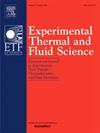利用可燃气体特性评价瓦斯爆炸自燃不稳定性
IF 2.8
2区 工程技术
Q2 ENGINEERING, MECHANICAL
Experimental Thermal and Fluid Science
Pub Date : 2024-12-17
DOI:10.1016/j.expthermflusci.2024.111398
引用次数: 0
摘要
预测火焰传播行为是准确评估瓦斯爆炸危险性的必要条件。然而,由于两种自发不稳定性,即扩散热不稳定性和达里厄-朗道(DL)不稳定性,没有人能够完全解释不稳定性的机制和影响因素。为了研究这些不稳定性,特别是DL不稳定性,用丙烷、甲烷和乙炔来抑制扩散热不稳定性的影响。结果表明,丙烷-空气和甲烷-空气混合物的实验表明,较低的刘易斯数能更快地达到较高的无量纲火焰速度。相比之下,乙炔-空气混合物表明,高刘易斯数和高膨胀比的实验从早期阶段受到干扰。从这些结果中,我们得出结论,较低的刘易斯数会导致扩散热不稳定性,然后在丙烷-空气和甲烷-空气混合物中,尽管燃烧速度较高,但DL不稳定性会增强扩散热不稳定性。相反,乙炔-空气混合物受到DL不稳定性和膨胀比的强烈影响。本文章由计算机程序翻译,如有差异,请以英文原文为准。
Using flammable gas characteristics to evaluate spontaneous flame instability in gas explosions
Predicting the behavior of flame propagation is necessary to assess the precise risk of gas explosions. However, due to the two types of spontaneous instability, diffusive-thermal instability and Darrieus-Landau (DL) instability, no one can fully explain the mechanism and what affects the instabilities. To investigate these instabilities, especially DL instability, propane, methane, and acetylene were used to restrain the effect of diffusive-thermal instability. As a result, propane-air and methane-air mixtures showed that experiments with lower Lewis numbers reached higher dimensionless flame velocities more quickly. In contrast, acetylene-air mixtures showed that experiments with higher Lewis numbers and higher expansion ratios were disturbed from the earlier phase. From these results, we concluded that lower Lewis numbers led to diffusive-thermal instability, which was then enhanced by DL instability in propane-air and methane-air mixtures, despite higher burning velocities. In contrast, acetylene-air mixtures are strongly affected by DL instability and the expansion ratio.
求助全文
通过发布文献求助,成功后即可免费获取论文全文。
去求助
来源期刊

Experimental Thermal and Fluid Science
工程技术-工程:机械
CiteScore
6.70
自引率
3.10%
发文量
159
审稿时长
34 days
期刊介绍:
Experimental Thermal and Fluid Science provides a forum for research emphasizing experimental work that enhances fundamental understanding of heat transfer, thermodynamics, and fluid mechanics. In addition to the principal areas of research, the journal covers research results in related fields, including combined heat and mass transfer, flows with phase transition, micro- and nano-scale systems, multiphase flow, combustion, radiative transfer, porous media, cryogenics, turbulence, and novel experimental techniques.
 求助内容:
求助内容: 应助结果提醒方式:
应助结果提醒方式:


